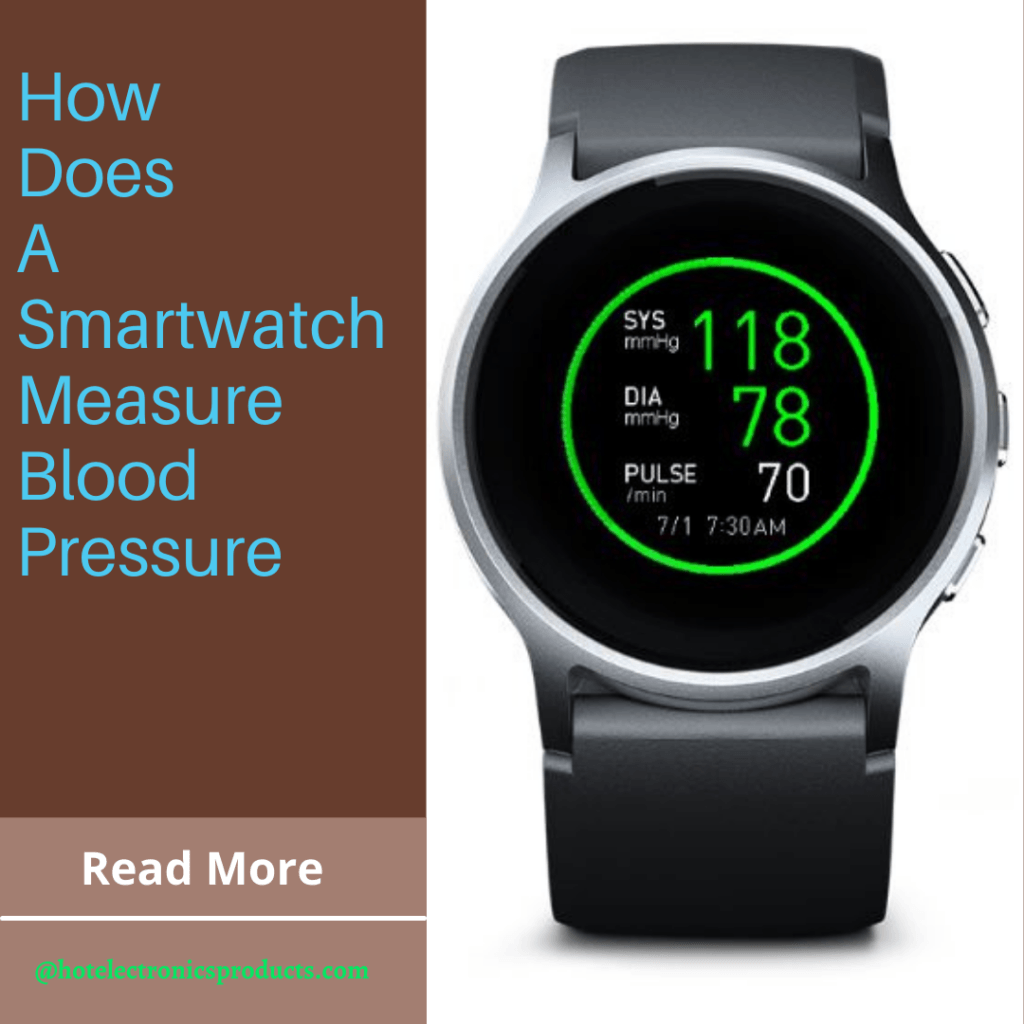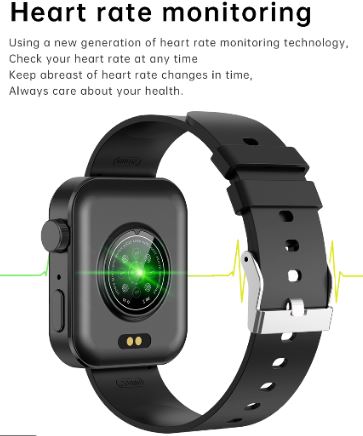Most wearable devices are using our wrist to record and analyze our health status. With advancements in technology, the measurement is becoming more accurate and detailed.
This article shares some of our findings with you so that you know how capable the latest smartwatch can be. The topic we like to focus on is the force of our blood flowing through the body – blood pressure.

Heart Rate Vs Blood Pressure
Many people confuse these two terms – heart rate and blood pressure. They are different and both have their own purpose and aim.
The heart rate refers to the number of times our heart beats per minute. Blood pressure is the pressure that pushes our blood flow through the vessels.
During exercise, the heart rate (pulse) is higher due to a faster heartbeat. Depending on your age, the range of heart rate varies as your body becomes older and weak.
Relationship between the two
There are findings that show an elevated heart rate also has elevated blood pressure. It helps to pre-alert any sign of high blood pressure, by monitoring the heart rate. [1]
Hypertension is a major public health issue in many countries. The topic of high blood pressure is an important matter every country must tackle. There is a high correlation between high blood pressure and other major illnesses.
Diseases like cardiovascular failure, stroke, and kidney disease begin with high blood pressure. Governments must educate and inform their citizen, the risk of high blood pressure.
Typical Value of Heart Rate and Blood Pressure
The normal resting heart rate for most of us is 60~100 beats per minute. Abnormal heart rates are those that fall below 60 bpm or higher than 100 bpm.
For athletic professionals, their heart rate can be as low as 40~60 bpm. It is because their muscle is much stronger, and is able to pump a larger amount of blood with each heartbeat.
The purpose of blood circulation within our body is to bring oxygen to all parts of our body. When there is a lack of oxygen, that particular organ may become damaged. Symptoms of oxygen shortage could be dizziness, fainting, shortness of breath, fatigue, etc.
Normal blood pressure is systolic of less than 120 mm Hg and diastolic of less than 80 mm Hg (120/80). If the blood pressure becomes high, it may cause changes in vision, chest pain, headache, etc.
Systolic pressure is the pressure inside the artery when the heart is contracting. The blood is pumping throughout the body.
Diastolic pressure is the pressure inside the artery when the heart is at rest and filled with blood.
Stage 1 high blood pressure is when the systolic pressure reaches 130~139 or diastolic pressure is 80~89 mm Hg.
Stage 2 high blood pressure is when systolic pressure hits 140 and above or diastolic pressure exceeds 90 and above. This stage is very critical and you need to take serious action to lower your blood pressure.
What Is Optical Heart Sensor
To measure the heart rate, the smartwatch needs a sensor mounted at the underside of its body. To get an accurate result, the sensor needs to press against the skin.
The optical heart sensor will emit light to penetrate through the skin. By measuring the flow rate of the blood in your body, the sensor can determine how fast your heart is beating.
How The Optical Sensor Measure The Heart Rate
The optical heart sensor works on the principle of photoplethysmography (PPG) to measure your heart rate. This technique is non-invasive and low cost, thus leading to the large adoption of wearable devices. The method uses light to shine into the skin and measure the amount of light scattered by the blood flow.
Our blood is red in colour because it reflects red light and absorbs green light. By using the green LED light at the underside of the smartwatch, it can detect the blood volume flows through our wrist.
When the heart is beating, blood flow through our wrist. By flashing the green LED light it can detect the blood flow and thus calculate how many times the heart is beating.
Next to the Green LED light you will see the photodiodes, these photodiodes measure how much of the green light is absorbed into the blood.

Some of the smartwatch makers like Apple use infrared light to measure the heart rate in the background, together with the Green LED light to measure the heart rate during fitness activities. Both readings will calculate the heart rate variability.
Pulse Sensor
There are various key components inside the smartwatch, and each serves its own purpose in performing the necessary functions.
When the heart pumps out the blood to other parts of our body, the change in volume of the blood vessel will create a pulse wave. The detector that monitors this pulse wave is a pulse sensor.
There are some manufacturers producing these sensors in the market. Here are a few of them:
- Reflection-Type Pulse Sensor from Rohm Semiconductor – BH1790GLC
- Optical Heart Rate Detection Sensor from PixArt Imaging Inc – PAH8132HU-IN
- Heart Rate Sensor from Maxim Integrated – MAX86141
Benefits Of Using Smartwatch To Measure Blood Pressure
- Smartwatch is a lightweight device and easy to carry along. This makes it very convenient to wear it on your wrist, offering 24/7 flexibility and accompanying you throughout the day.
- There are third-party apps providing all kinds of applications that you can download from the app store like WearOS or WatchOS.
- Many sensors can embed onto the smartwatch, thus giving you more precise and complete monitoring and measuring of your overall health status at any given time.
- Data collected from the smartwatch can synchronize with the smartphone in real-time, thus giving you instantaneous results and responses.
What Disadvantages In Using Smartwatch To Measure Blood Pressure
- Smartwatch uses a wrist-based method to measure blood pressure. But, this kind of measurement failed to prove as accurate as traditional blood pressure cuffs.
- The battery power of the smartwatch has a limit, for example, Apple Watch only lasts up to 18 hours.
- Operating the smartwatch may poise some resistance to non-tech-savvy users.
What Are The Traditional Methods Used To Measure Blood Pressure
Traditionally, nurses use a blood pressure cuff and stethoscope to measure blood pressure. It requires stopping the circulation of the blood flow using a wrist strap in a short moment. With the introduction of electronic blood pressure monitors, more people are taking their own reading at home.
But, the conventional arm cuff design may not be well designed for large patients. It also requires a bigger space to accommodate the large device for the blood pressure measurement.
Currently, only Omron HeartGuide is recognized by FDA (Food and Drug Administration) to deliver accurate blood pressure readings. Omron release the watch in early 2019 and has received wide coverage as of today.
Both Fitbit Sense and Samsung Galaxy Watch have got the approval from FDA on its ECG app, to track the heart rhythms for any rapid and irregular heartbeat. This is the symptom of Atrial Fibrillation (AFib).
What Need To Consider When Measuring the Blood Pressure
Knowing your blood pressure is vital to ensure that your health is in good condition. Hence, you need to consider those issues below when doing the measurement:
| # | What To Consider |
| 1 | Relax your body before and during the blood pressure measurement. |
| 2 | Make sure the measuring device is in good condition and working fine. |
| 3 | Ensure the accuracy of the smartwatch when doing the measurement. |
| 4 | Do calibration monthly to ensure the accuracy of the data measured and collected. |
| 5 | Compare your data with those at hospitals or clinics provided by doctors, professionals, and nurses. |
| 6 | Measure the blood pressure twice daily, the first measurement in the morning and the 2nd one in the evening. Each time takes 2 or 3 readings to ensure the measurements are consistent. |
| 7 | Avoid exercise, coffee or tea, smoking half an hour before taking the readings. |
What Are The Feedbacks Using Smartwatch To Measure Blood Pressure
1. from Professional like Doctors and Researchers
There are medical practitioners who feel that the smartwatch will help to end “white coat syndrome”, where the patient’s blood pressure is being elevated due to stress in a doctor or hospital location.
Since the smartwatch can track and measure blood pressure at home with ease, the above error will not happen. Furthermore, it encourages more patients to watch and check their blood pressure more frequently, anytime and everywhere.
There are benefits of better patient-physician follow-up as the data recorded on the smartwatch can send remotely to them for analysis and seeking advice. Doctors and nurses can help to manage a patient’s blood pressure virtually, utilizing the data recorded on the smartwatch.
Using a smartwatch to check the health condition of the patients will allow decentralization of healthcare delivery to each home. Data from smartwatches can help to predict any illness and other abnormalities in a patient’s health
Even though, still, some groups of doctors and researchers feel that the smartwatch method has not yet been properly validated. It may take a few more years for them to agree on using this new way of checking the health status of their patients.
2. from consumers
Most consumers find that using a smartwatch to measure their blood pressure is so much convenient. The readings can store on the watch and do analysis at later dates. The data provides useful information for doctors and professionals to tell them about their health conditions.
Yet, some of them have concerns about the accuracy and reliability of the measurement. It is also difficult and hard to use for a minority of consumers, as they are not so tech-savvy. Especially the synchronization of the smartwatch with a smartphone, senior adults find it hard to follow through.
3. from Smartwatch makers
Smartwatch manufacturers think that there is more room to expand its features and functions. Soon, there will have more advanced features to watch and track our health with better accuracy.
A recent trial test by Fitbit shows that its smartwatch can use to measure blood pressure from the wrist. The company is planning to extend more testing with a larger population. Fitbit focuses on measuring the pulse arrival time to determine the blood pressure.
Samsung is exploring an optical heart rate sensor on the Galaxy Watch, to measure blood pressure at the wrist. The company estimates blood pressure by measuring pulse transit time.
Conclusion
Wearable devices like smartwatches will become part of our daily necessities, like wearing our cloth. The benefits of the smartwatch helping us to track and give warning to our health will encourage more people to use it every day.
We look forward to seeing more advanced and powerful smartwatches coming onboard in 2022 and beyond.
If you wish to explore those smartwatches which focus on tracking our health aspect, check out other articles which we have written here for your reading and extra knowledge.



Hi Thomas, thanks for sharing such a detailed explanation about how a smartwatch measures our blood pressure. It is good to know from different points of view as well and educate ourselves how a technological product can be beneficial to our health. I also like your sharing about what to consider before measuring blood pressure, very helpful! Thanks again, Grace
Hi Grace,
Thank you for the comment.
According to World Health Organization, number of people having high blood pressure has increased a lot since 1990. It is now 1.28 billion as of August 2021, and more than 700 million do not have proper treatment.
We hope that with the help of smartwatch, more people will track their health status often and take preventive action early.
Statistics from Strategy Analytics shows that globally smartwatches shipment reaches 18 million units in Q2 of 2021. About 50% (9.5 million) belongs to Apple Watches, the number 1 Smartwatch maker in the world.
More makers from China and India are coming onboard and we foresee more features and better affordability to the general consumers.
Technology really can help us to do many things, tracking and monitoring our blood pressure should become part of our daily routine. Let us spread the words to as many people as possible, to use smartwatch in good way.
You know, I have always wondered how a watch can measure your blood pressure. The power of technology is just phenomenal. I have recently purchased myself a watch and I absolutely love it. It has made working out so much easier for me. Thank you for this lovely post, I will be sire to share this article with friends and family.
Hi Daniel,
I am happy to hear that you love this article. Congratulation of getting your smartwatch which you love so much. Make full use of those health features on your watch whenever you do your workout.
Personally I track my blood pressure before and after each exercise, especially when I go for long run. Knowing your blood pressure status will prevent you from overexert your body, leading to body injury.
Using my smartwatch to measure the blood pressure is so much convenient. I can do it outdoor while I was in the park or garden. Wish more people can consider to get one themselves.
How much can Blood Pressure actually fluctuate during the day?, like any normal activity like walking, gardening, washing dishes, TV, sending emails and browsing, chatting with family and friends, sleeping etc etc…. .. so is it good idea to wear a smartwatch during any given day to reflect readings on any activity one may be doing at any time?
Thankyou
Hi Peter,
It is normal for our blood pressure to fluctuate in a day, depending on what kind of activities we are performing.
Strenuous activity like fast running will cause our blood pressure to shoot up while resting on a sofa will relax our body and lower our blood pressure. The time of the day also has an influence over our blood pressure, with mid-day usually the highest and at night the lowerest.
Walking, gardening and washing dishes are considered a form of exercise, and the normal BP is 160 to 220 mm Hg. Watching TV, chatting with friends, and sleeping are low activities therefore BP value is most likely lower by 10 to 20%.
The health benefits of wearing a smartwatch to monitor our blood pressure and other medical health data can be found in many publications, there is no doubt about it.
Smartwatch has become a common wearable device for many people, and we expect them to be more affordable and sophisticated in the coming years. It is good to have one and start exploring its features and function in your daily life.